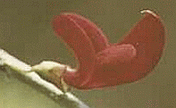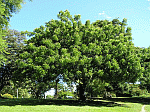
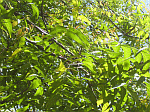

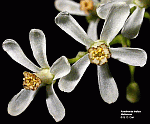
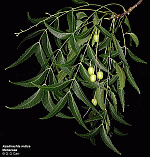
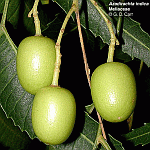
|

Plant Family: Belongs to the Meliaceae family, which includes the Mahoganies – Large Leaf or Honduran Mahogany (Swietenia macrophylla) and Small Leaf or Cuban Mahogany (S. mahagoni).
Description: Located in the Gardens on lawn near Forestry office; medium sized tree, 15-20 m tall (50-65 ft); is quick growing, gaining up to 3 m per year (10 ft) under optimum conditions; stem short and straight; branches long and spreading, forming dense, large, oval or rounded crown; leaves pinnately compound, to 25 cm (10 in), with terminal leaflet and about 8 pairs of ovate or lanceolate leaflets, 6-8 cm long (2-3 in) and 1-3 cm wide (0.4-1.2 in), with serrated margins; bears many, small white to cream flowers in panicle bunches, 10-30 cm long (4-12 in); fruit an ellipsoid drupe (fleshy with single seed), 1-2 cm long (0.4-0.8 in), greenish yellow when ripe; flowering and fruiting in about 5 years; flowers in dry season and fruit ripens in early part of wet season.
Natural Habitat: An extraordinarily hardy tree; grows in wide range of temperature and rainfall ecosystems, from the Sahara Desert to the wet salty environment of the Florida Keys; does best in seasonal climates with long dry season.
Origin and Distribution: Native to India; introduced and widely cultivated in many semi-arid and sub-humid areas of Asia, Africa, Australia, Latin America and the US; in natural habitat common up to 700 m (2300 ft), but, depending on climate, will grow at elevations up to 1500 m (5000 ft); propagation by seed, which only viable for about 30 days after harvest.
Uses: Called "the village pharmacy" and "the curer of all ailments" in its native India; is one of most ancient and widely used herbs in the world; Neem leaf extract is used as an antiviral, for example, against the flu, common cold, herpes and dengue fever; the strong-smelling, aromatic oil obtained from fruit is much valued in Indian native medicine for various illnesses such as leprosy and rheumatism; another attribute is the effectiveness of seed and leaf extract as a natural insecticide, and it is proving equally effective in repelling pests that affect people, like mosquitoes, fleas, ticks and head lice; yields an antiseptic resin used medicinally and in toothpaste, soaps, and lotions; wood very durable, used for furniture and crafts; it is also a valuable shade tree; grown as an ornamental in Dominica.
Indigenous Legends: Reportedly, herbalists in ancient India had documented the healing qualities of this tree long before Western civilization discovered the analgesic qualities of the willow tree from which aspirin is derived.
References:
Lars Schmit and Dorthe Joker. Azadirachta indica. Danida Forest Seed Center, Humlebaek, Denmark 2000 (dfsc.dk)
C.D. Adams. Flowering Plants of Jamaica. University of the West Indies, Mona, Glasgow University Press 1972
H.F. Macmillan. Tropical Planting and Gardening. Macmillan, London 1956
How to Grow Neem. Neem Tree Farms Co., Brandon, Florida n.d. (neemtreefarms.com)
Gerald Carr. Flowering Plant Families. Univ. of Hawaii, Honolulu, Hawaii 2004 (botany.hawaii.edu)
Robert A. De Filipps. Useful Plants of the Commonwealth of Dominica, West Indies. Smithsonian Institution, Washington, D.C. 1998
|

